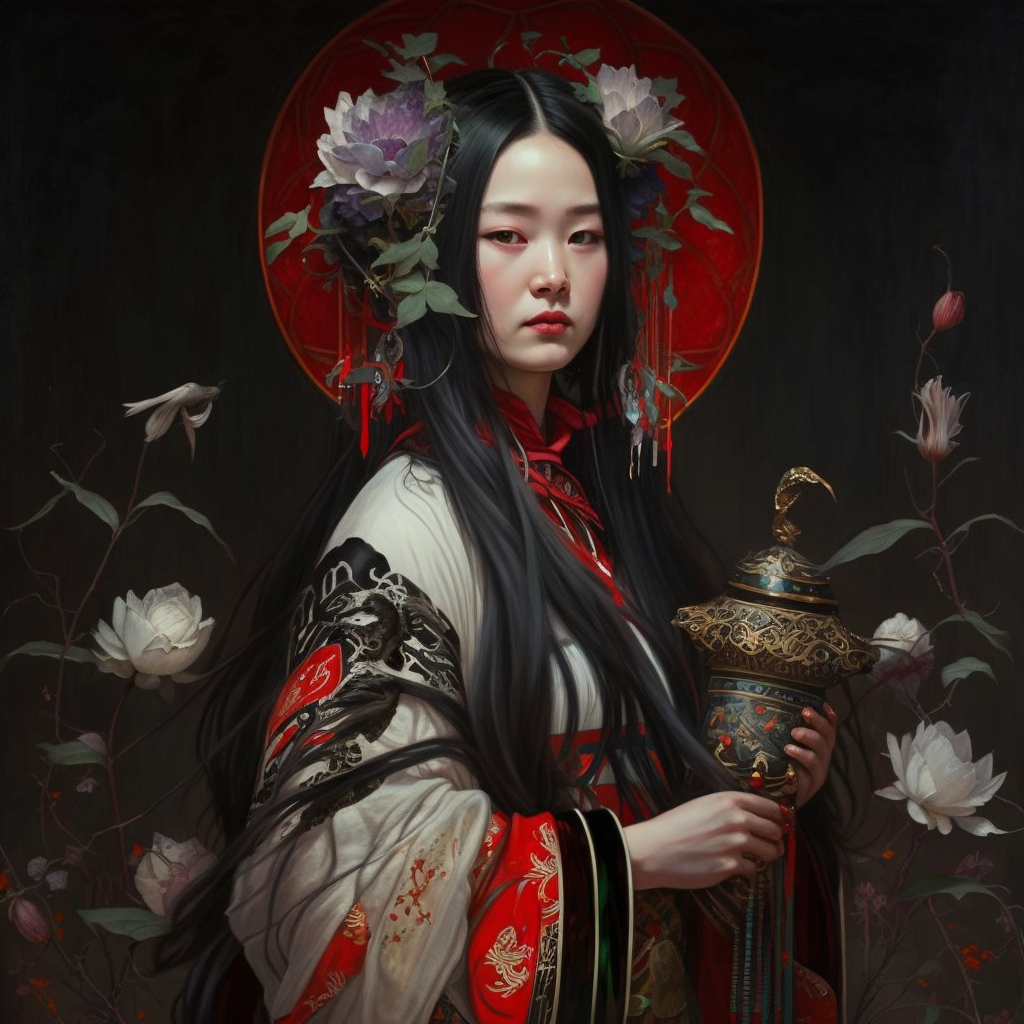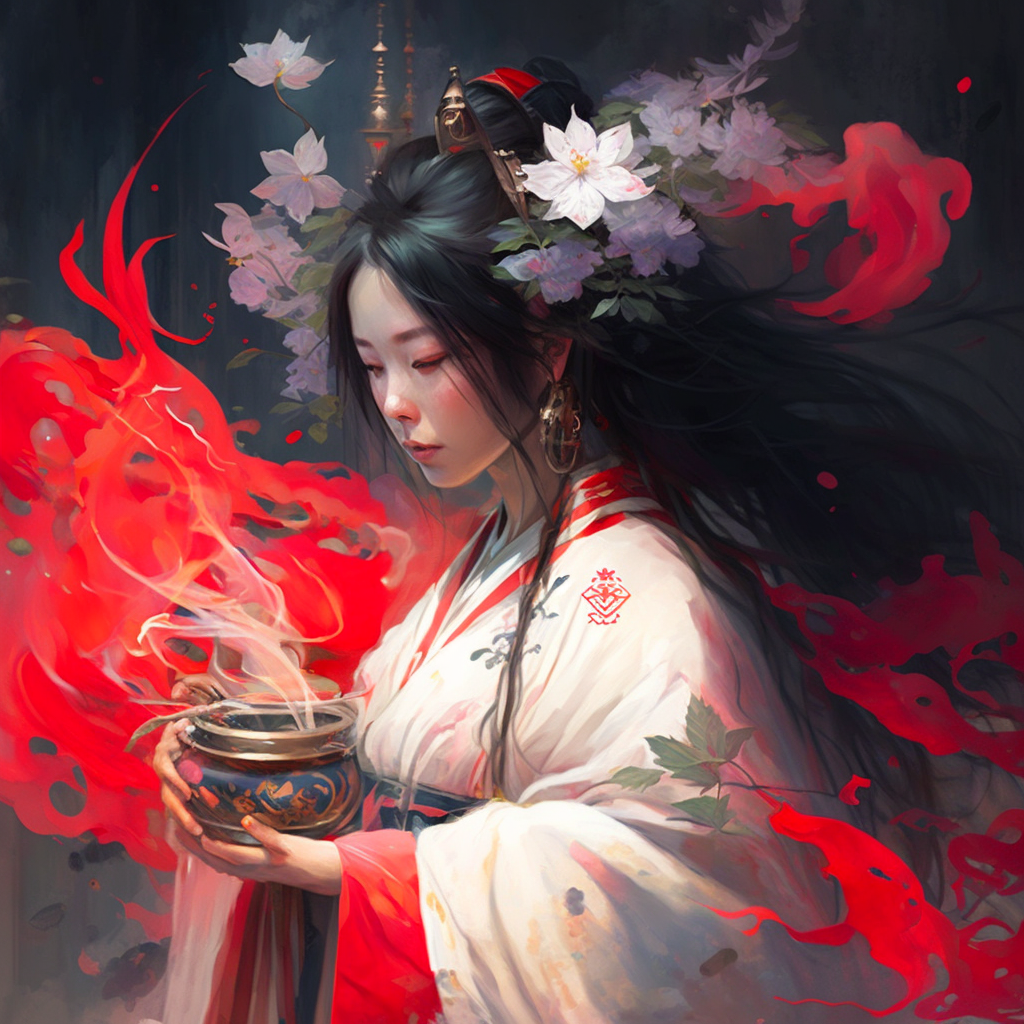Goddess, Ame-no-Uzume

Ame-no-Uzume is a Shinto goddess of dawn, revelry, and mirth.
- Pantheon: Shinto
- Deity Title: Ame-no-Uzume, the goddess of dawn and revelry
- Deity Symbol: Ame-no-Uzume is often depicted holding up her skirts in a lively dance
- Home Plane: Takamagahara
- Deity Level: Intermediate
- Alignment: Chaotic Good
- Aliases: Uzume, Ame-no-Uzume-no-Mikoto
- Superior: Amaterasu
- Traditional Allies: Inari, Ebisu
- Traditional Foes: Susanoo, Raijin
- Divine Artifact: Kagura suzu, a set of bells used in Shinto rituals and dance performances
- Servants: Kitsune, fox spirits who serve as messengers and protectors of Inari and Uzume
- Servitor Creatures: Tengu, bird-like spirits who serve as messengers and guardians of the mountains
- Sacred Animal: Fox
- Manifestations: Ame-no-Uzume is often depicted as a beautiful, energetic woman dressed in traditional Japanese clothing and dancing with joy
- Signs of Favor: Rainbows, sudden bursts of energy and joy, successful harvests
- Worshipers: Actors, dancers, musicians, farmers, those seeking joy and inspiration
- Cleric Alignments: CG, CN, NG
- Specialty Priests: Dawnbringers, who specialize in spreading joy and hope
- Holy Days: Ame-no-Uzume Matsuri, a festival held in her honor on the 3rd day of the 3rd lunar month
- Portfolio: Dawn, revelry, dance, inspiration, joy, fertility
- Domains: Chaos, Charm, Community, Good, Luck
- Favored Weapon: Wakizashi
- Favored Class: Bard
- Favored Race: Kitsune
- Duties of the Priesthood: Spreading joy and hope, performing Kagura dance rituals, promoting fertility and a successful harvest
- Major Cult/Temple Sites: Amanoiwato Shrine in Ise, Japan; Uzume Shrine in Kyoto, Japan
- Benefits: Clerics and specialty priests of Ame-no-Uzume gain proficiency in Performance and gain access to the spell list associated with the Charm and Good domains. They also gain the ability to perform the Kagura dance, which can inspire allies and disorient enemies. Additionally, they have the ability to call upon fox and tengu spirits for aid in battle and protection.
Ame-no-Uzume is a Shinto goddess known for her joyful and exuberant personality. As the goddess of dawn and revelry, she is known to be the life of the party and always eager to have a good time. However, there is more to her than just her love of celebrations.
Born from the gods Izanami and Izanagi, Ame-no-Uzume’s birth caused her mother’s death, leading her to be ostracized by the other gods for many years. Despite this, she refused to let the pain of her past hold her back, and instead became a symbol of perseverance and hope.
As a character, Ame-no-Uzume is charismatic and energetic, with a quick wit and a sharp tongue. She is fiercely loyal to those she cares about, and is not afraid to stand up for what she believes in. Her ultimate goal is to bring joy and happiness to the world, and she does so by using her talents as a performer and entertainer to lift the spirits of those around her.
In addition to her role as a goddess of dawn and revelry, Ame-no-Uzume is also known as a patron of the arts and a protector of women. She is often depicted dancing and playing music, and is said to have inspired the creation of the Kagura dance, which is still performed in Japan today.
Despite her cheerful nature, Ame-no-Uzume has also been known to use her wit and cunning to achieve her goals. In one famous story, she tricks the sun goddess Amaterasu out of hiding and back into the world, using her skills as a performer to create a raucous celebration that draws Amaterasu’s curiosity and brings her out of her cave.
She appears as a youthful woman with long black hair and fair skin. She is often depicted wearing a traditional white robe with a red hemline, and a headdress adorned with flowers and ribbons. In her hands, she holds wooden clappers or small drums, which she uses to create music and dance. Her bright and cheerful personality is reflected in her lively movements and mischievous expression.
Overall, Ame-no-Uzume is a complex and multifaceted character, whose love of joy and celebration is matched only by her fierce determination and unwavering spirit.
Ame-no-Uzume

Deity of Festivals, Dance, and Laughter, Chaotic Good
Armor Class: 20 (natural armor)
Hit Points: 500 (50d10 + 250)
ith the mods
| STR | DEX | CON | INT | WIS | CHA |
|---|---|---|---|---|---|
| 22 (+6) | 28 (+9) | 24 (+7) | 20 (+5) | 24 (+7) | 30 (+10) |
Regenerate respons
Speed: 60 ft.
Skills: Acrobatics +20, Insight +18, Performance +25
Senses: Truesight 120 ft., passive Perception 22
Languages: All
Challenge Rating: 30 (155,000 XP)
Traits
Divine Awareness. She can sense the presence of all creatures within 1 mile of her.
Divine Magic. She can cast any spell from the Life, Light, and Trickery domains, as well as the following spells:
- Confusion
- Crown of Madness
- Dancing Lights
- Disguise Self
- Faerie Fire
- Guiding Bolt
- Hypnotic Pattern
- Invisibility
- Mirror Image
- Phantasmal Force
- Silence
- Sleep
- Suggestion
- Tasha’s Hideous Laughter
Legendary Resistance (3/Day). If Ame-no-Uzume fails a saving throw, she can choose to succeed instead.
Magic Resistance. Ame-no-Uzume has advantage on saving throws against spells and other magical effects.
Magic Weapons. Ame-no-Uzume’s weapon attacks are magical.
Actions
Multiattack. Ame-no-Uzume can make three attacks: two with her fists and one with her foot.
Fist. Melee Weapon Attack: +20 to hit, reach 10 ft., one target. Hit: 24 (4d8 + 10) bludgeoning damage.
Foot. Melee Weapon Attack: +20 to hit, reach 10 ft., one target. Hit: 24 (4d8 + 10) bludgeoning damage.
Dancing Laughter (1/Day). Ame-no-Uzume performs a dance, filling the area within 120 ft. of her with joy and laughter. Each creature within the area must make a DC 25 Wisdom saving throw or be charmed and incapacitated for 1 minute. A creature can repeat the saving throw at the end of each of its turns, ending the effect on itself on a success.
Divine Artifacts
Magatama of Laughter. Ame-no-Uzume wears a magatama (a curved bead) made of jade around her neck. The magatama grants her the ability to cast Tasha’s Hideous Laughter at will.
Legendary Actions
Ame-no-Uzume can take 3 legendary actions, choosing from the options below. Only one legendary action option can be used at a time, and only at the end of another creature’s turn. Ame-no-Uzume regains spent legendary actions at the start of her turn.
- Fist or Foot. Ame-no-Uzume makes one attack with her fist or foot
- Laughing Charm. Ame-no-Uzume targets one creature within 60 ft. of her that she can see. The creature must succeed on a DC 25 Wisdom saving throw or be charmed and unable to take reactions until the end of its next turn.
- Joyous Step. She moves up to her speed without provoking opportunity attacks.
- Divine Inspiration (Costs 2 Actions). Ame-no-Uzume grants inspiration to one creature within 60 ft. of her that she can see. The creature gains advantage on its next attack roll, ability check, or saving throw within the next minute.
Regional Effects
The region where Ame-no-Uzume makes her home is filled with the sounds of laughter and music. The following effects are present in the area:
- All creatures within 1 mile of Ame-no-Uzume gain advantage on Performance checks.
- Any performance or festival held in the region is blessed by Ame-no-Uzume, granting all participants inspiration.
- Creatures with the ability to charm or incapacitate others gain a +2 bonus to their spell save DCs.
- Any creature attempting to perform a hostile action against Ame-no-Uzume or her followers within the region must make a DC 25 Wisdom saving throw or become charmed and unable to take that action.
This effect lasts as long as Ame-no-Uzume remains in the region, and for 1d10 days after she leaves.
Overall, Ame-no-Uzume is a powerful and whimsical deity, focused on bringing joy and laughter to the world. Her high stats and abilities make her a formidable opponent for any adventurers who cross her path, but her overall goal is not one of destruction or conquest. Instead, she wants to spread happiness and revelry throughout the world, and her worshippers work hard to make sure that their festivals and celebrations honor her and bring people together in a spirit of community and joy.

 Buy me a coffee
Buy me a coffee